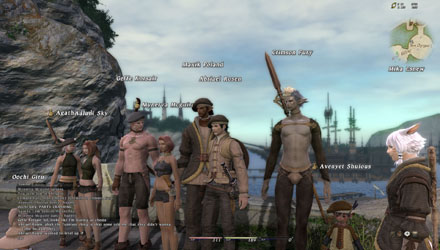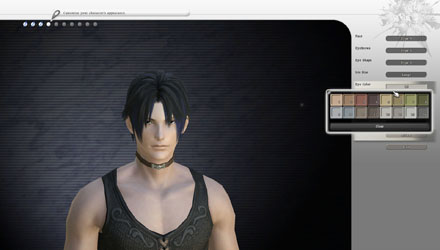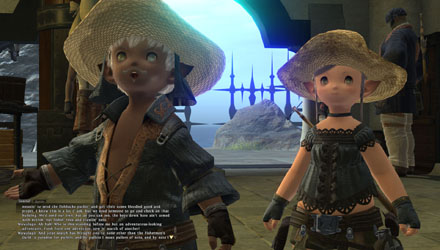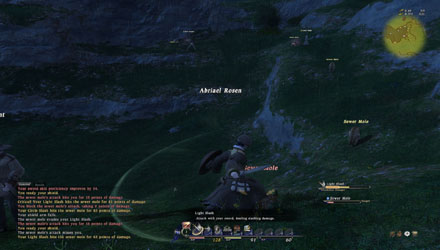Features & News
Hands on: Final Fantasy XIV Beta
August 13, 2010, Author: Giuseppe Nelva
As the closed beta testing for Final Fantasy XIV moved from phase two to phase three, the NDA has been partially dropped (posting movies still isn’t allowed), allowing me to finally share my impressions and opinions on the game.
Unfortunately even the beta testers don’t know that much about what the game will be like at release. Even now that we are little more than one month from the release of the collectors edition (September the 22nd, while the standard edition will be released on September the 30th), the beta test client is strictly level capped and only one of the three starting cities and the surrounding areas are available.
While this is unsurprising, considering that Square Enix normally puts most of the weight of the testing of their games on their internal QA team instead of volunteer beta testers, it means that most of the game is still a mystery, and will very possibly remain one until the game hits the shelves.
First of all, I have to say that Final Fantasy XIV sports one of the best graphical presentations (if not the best, overall) I ever seen in a MMORPG. Characters are extremely detailed, both in their features and in the design of their clothing, and shows the usual creativity that we’ve come to love in previous Square Enix titles. Areas are lush, rich and extremely vast. They’re also beautifully decorated by a whole slew of environmental and weather effects like rain and sandstorms, which really help in turning the land of Eorzea into a living and breathing world.
One of the elements that characterizes Final Fantasy XIV’s graphics is the extensive use of normal maps that give materials a very nice three-dimensional look, bringing out details and creating a very visible divide with the looks of most other MMORPGs. Obviously there can’t be a Beta Hands-on article without a whole slew of screenshots, and you can find an extensive gallery of full resolution ones here.
Unfortunately, this kind of graphical prowess comes with a downside, and that would be a pretty demanding list of hardware requirements; definitely above the average of today’s MMORPGs. The minimum specs require a dual core processor and a Geforce 9600 (or ATI 2900), but, at least as far as the beta goes a more powerful gaming PC is necessary in order to reach a decent performance.
Personally I tested the game with an AMD Phenom II X4 965, an overclocked Geforce GTX 460 with 1 Gigabyte of video RAM and 4 Gigabytes of RAM on Windows 7 64 bit, and the game struggles in holding thirty frames per second at 1080p resolution and 4x Antialiasing, dropping to fifteen in the most crowded areas.
It’s quite obvious that this kind of performance on what’s decidedly a high-end gaming PC is unacceptable, requiring a whole lot of further optimization before the game will be ready for the shelves. It’s unsurprising that Square Enix decided to delay the PS3 version to march, given that even PCs way above the requirements struggle with the graphics at the moment. Hopefully Square Enix is aware of the fact that such a lousy performance might seriously impair the success of the game at launch, and will do the necessary adjustments.

The graphics are gorgeous, but also quite demanding
Back to more positive notes, the character creation is very extensive for a MMORPG and offers plenty options to customize one’s avatar. A sizable difference with Final Fantasy XI and most other MMOs is that all the races (Hyur, Elzen, Lalafell, Miqo’te and Roegadyn) start and progress with the same stats. This means that your choice of race will simply be a matter of looks and/or roleplay. Maybe you want to play a tank but you also like the diminutive Lalafell? You will be able to do so without feeling impaired by your initial statistics. The same goes for any other possible combination.
Customization is further expanded by the fact that every race is split into two tribes with distinctive looks. For instance the Elzen (the successors of Final Fantasy XI’s Elvaan and resemble the classic fantasy Elf) are divided between Wildowood and Duskwight, basically wood elves and dark elves. Even here, of course, the difference is exclusively cosmetic. A slightly jarring flaw, at least for me, is the absence of female Highlanders (the second Hyur, or human, tribe, characterized by strong and muscular bodies), which basically bars the existence of any muscular or buffed-up female characters. The only other race with a rather bulky frame is the Roegadyn, which on par with their predecessors, Final Fantasy XI’s Galkas, don’t have females eitherl.
This design choice reminds me of the sad exclusion of female Chosen from Warhammer Online, and makes me wonder why MMORPG character designers are generally so wary of creating muscular female characters. In every other kind of media there are plenty representation of strong, muscular women that still retain a lot of femininity. Even anime and manga show quite a few, without mentioning other genres of games, including JRPGs. In the end, fans of “big girls” will probably feel a little bit left out.
Moving past the choice of race, the customization choices are quite varied. facial features like the shape of nose, eyes, eyebrows, chin and lips are chosen separately, allowing for a metric ton of different variations. Only the number of hairstyles and facial hair still seem, at least for some races, a bit limited. There also are some additional details, like scars and colorable facial tattoos, which help making a character quite unique in his looks. What allows for the most variation are the colors, sporting thirty two different hues per race for hair and sixteen for eyes and skin. A very welcome addition is the ability two chose between thirty two colors for hair highlights, adding a lot to the uniqueness of each character, provided that you’re willing to sport a rather punkish look. Finally, you can chose your body size between five options and a few more details for certain races, like tail type for Miqo’te characters.

The character creation allows for extensive customization
Equipment adds a lot to the uniqueness of each character, thanks to the fact that the number of gear slots characters are decked with what is decidedly high compared to most MMORPGs, and all those trinkets appear visually on the character model. Things like earrings and eyewear (masks, glasses eye-patches) definitely help in giving a character a unique feel. Overall, the character customization options are extensive and allow for a lot of variation, even if some aspects could still use some expansion. Luckily Square Enix is adding more options gradually, so it’s very likely that we’ll see quite a lot more at release.
Animations are another strong point of the game. Square Enix animators prove once more that they really mastered motion capture and everything looks very natural, from fighting to crafting. An extensive emote system acts as a crown jewel for the animations, especially due to the lovely expressions the character’s (faces and facial features are fully modeled and animated) display while executing them. Role-players will feel right at home with Final Fantasy XIV thanks to the ability to portray emotions very naturally and extensively. While personally I’m not much of a fan of dancing in MMORPGs, the game could use a little more variety in dancing emotes to appease the numerous fans of that kind of feature, especially given how good the overall animations are. That can easily come further down the line, though.
One of the most important features of a MMORPG is obviously the control system. Before the third phase of the beta, controlling a character with a keyboard and a mouse was basically impossible, due to an extremely clumsy mouse camera control that made playing with a Joypad the only viable option. Luckily phase three demonstrated that Square Enix is working very hard in making the mouse/keyboard combination viable and effective, improving the mouse camera control quite a lot, even if it can still use some tweaking. Playing with a controller is mostly flawless (I tried with both the PS3 and the Xbox 360 controllers and both were very effective), but it’s slightly uncomfortable to move your hands to the keyboard in order to communicate. On the other hand a joypad definitely can’t compete with a keyboard in executing commands from the action bars and macros. Personally, at the moment, I found my best control setup holding the joypad with one hand for camera and movement (the analog stick allows for much more precise movement than the digital input from the keyboard) and using my other hand to execute actions on my keyboard. It’s by no means ideal, but it gets the job done. A little more tweaking to the mouse camera control will probably prompt me to finally dump the controller.
It’s unfortunate that (despite the promises) Microsoft never released a driver for using the xbox 360 chatpad with the PC, because the combination of Xbox 360 controller and chatpad would probably make for the perfect control solution. On the other hand the PS3 keypad connects seamlessly via bluetooth to your PC without even needing a driver, but if you’re using Windows 7 64 Bit you might find yourself facing some driver problems in order to get the actual PS3 controller to work (the homebrew drivers that are available on the net aren’t signed, and Windows 7 64 doesn’t like that). I really wish that Sony would release some official drivers to let us use a Dualshock 3 with Windows-based PCs without having to resort to homebrew software.

The Lalafell retain the absolute cuteness of the Tarutaru from FFXI
In any case Square Enix really needs to optimize the Mouse/Keyboard combination before release, because for least six months, Final Fantasy XIV will be a PC exclusive game and many PC gamers won’t be welcoming towards the possibility of being forced to buy a console-like controller in order to play a PC game decently.
Combat is very fast, and while it retains some of the elements of Final Fantasy XI, like skill chains (slightly changed and renamed Battle Regimens), it’s much different under many other aspects. First of all, it’s decidedly much faster, with no autoattack, with even the simplest slash attack corresponding to a mouse/button press. Actions are available on an pretty standard action bar and on top of it you can still create complex macros similar to the ones found in Final Fantasy XI.
All in all we’re looking at a more responsive and more intuitive hybrid between the macro-based combat from Final Fantasy XI and the action bar-based battle systems of other MMORPGs. It’s basically the best of both worlds, and personally I feel it works extremely well, both in solo and group gameplay. Every action you perform will use part of your action bar (that refills quite quickly overtime), limiting the ability to spam attacks and improving the tactical aspect of the game. On the other hand, just like in Final Fantasy XI, your Technique points will increase as you hit the enemy or get hit, allowing you to spend them to perform special attacks and spells.
One of the most interesting features is the use of the shield. While in most other MMORPGs your shield is just “there” and will automatically block some incoming blows, its use in Final Fantasy is more active. You won’t have to manually block every blow, but you will have to raise your defense actively with the “guard” ability, giving you a few seconds during which the character will partially or completely block incoming blows before the defense lowers again. Since raising your defense uses up part of your action bar, tanking becomes more tactical than in other games, as you will have to coordinate your shield with your attacks. Spamming attacks too fast will very possibly leave you with your action bar empty when your shield drops, open to full strength attacks from the enemy. On the other hand, being too conservative with attacking will make your aggro control looser, impairing your ability to tank.
This kind of challenge is exactly what can get an old “all-tank” MMORPG player like me pumped up for a game. After Final Fantasy XI, only Age of Conan made tanking any real challenge. At long last Final Fantasy XIV seems to be set to turn tanking into serious business again.

It's Final Fantasy, expect critters at low levels...
Character progression is one of the most interesting features of the game so far. By completing basically every kind of action (crafting included) you gain experience that allows you to progress vertically with your physical level, giving you a certain amount of points to freely allocate to your stats and to elemental resistances (for now you can use them quite freely, just having to wait a cooldown period between reallocation). On the other hand, there’s a horizontal class system that only loosely recalls the job system of Final Fantasy XI.
Pages: 1 2Feature Type: Hands On | Tagged beta, Final Fantay XIV, Hands-on, PC, Windows


